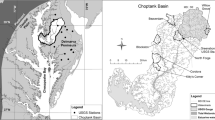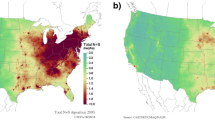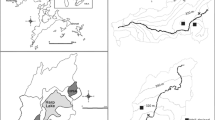Abstract
We examined total Kjeldahl nitrogen (TKN) loading to a small forested stream during storm events. We hypothesized that upper soil and litter layers in riparian area are primary source of higher TKN concentrations during storm. A storm water sampling program was carried out to gather requisite flow and water quality data to calibrate and validate water and nutrient components of the Riparian Ecosystem Management Model for TKN. Water quality and storm flow data collected from January 2000 to December 2003 were used to simulate the hydrology and nitrogen transport over a second-order watershed within the Fort Benning Military Installation, Georgia. Intensive sampling conducted from October 2002 to May 2003 provided the necessary data to characterize the rising limb, peak, and recession limb of six major storm events. Simulated runoff and storm TKN loads were compared with their corresponding observed or calculated values. Hydrology and nitrogen data collected from February 21, 2003 to December 31, 2003 were used for the model validation. The hydrology component of the model showed a Nash-Sutcliffe efficiency of 87% for the validation period. The average absolute difference between simulated and calculated TKN loads was 25%. Even though the monthly water budget indicated the dominance of subsurface flow, TKN contribution from direct runoff was significantly greater than that from subsurface flow. On an average, 73% of the observed total TKN load at the watershed outlet was contributed by surface runoff during storm events. The results suggested that the surface runoff during the storm events washed off the nitrogen from the forest floor and transported to the stream.





Similar content being viewed by others
References
Bhat S, Jacobs JM, Hatfield K, Prenger J (2006) Relationships between stream water chemistry and military land use in forested watersheds in Fort Benning, Georgia. Ecol Indicators 6:458–466
Bryant ML, Bhat S, Jacobs JM (2005) Characterization and modeling of throughfall temporal variability for forest communities in the southeastern U.S. J Hydrol 312:95–108
Burton TM, Turner RR, Harris RC (1977) Nutrient export from three north Florida watersheds in contrasting land use. In: Correl DL (ed) Watershed research in eastern north America. Smithsonian Institution, Edgewater, MD, USA, pp 323–342
Campbell JL, Hornbeck JW, McDowell WH, Buso DC, Shanley JB, Likens GE (2000) Dissolved organic nitrogen budgets for upland, forested ecosystems in New England. Biogeochemistry 49:123–142
Cirmo CP, McDonnell JJ (1997) Linking the hydrologic and biogeochemical controls on nitrogen transport in near-stream zones of temperate-forested catchments: a review. J Hydrol 199:88–120
Duff JH, Triska FJ (2000) Nitrogen biogeochemistry and surface–subsurface exchange in streams. In: Jones JB, Mulholland PJ (eds) Streams and Groundwaters. Academic Press, San Diego, CA, pp 197–220
Fox DG (1981) Judging air quality model performance: a summary of the AMS workshop on Dispersion Model Performance. B Am Met Soc 62:599–609
Frank H, Schleppi P, Peter W, Hannes F (2000) Export of dissolved organic carbon and nitrogen from Gleysol dominated catchments – the significance of water flow paths. Biogeochemistry 50:137–161
Garten CT, Ashwood TL, Dale VH (2003) Effect of military training on indicators of soil quality at Fort Benning, Georgia. Ecol Indicators 3:171–179
Heathwaite AL, Johnes PJ, Peters NE (1996) Trends in nutrients. Hydrol Process 10:263–293
Houser JN, Mulholland PJ, Maloney KO (2006) Upland disturbance affects headwater stream nutrients and suspended sediments during baseflow and stormflow. J Environ Qual 35:352–365
Inamdar SP, Sheridan JM, Williams RG, Bosch DD, Lowrance RR, Altier LS, Thomas DL (1999a) Riparian Ecosystem Management Model (REMM): I. Testing of the hydrologic component for a Coastal Plain riparian system. T ASAE 42:1679–1689
Inamdar SP, Lowrance RR, Altier LS, Williams RG, Hubbard RK (1999b) Riparian Ecosystem Management Model (REMM): II. Testing of the water quality and nutrient cycling component for a Coastal Plain riparian system. T ASAE 42:1691–1707
Iverson RM, Hinckley BS, Webb RM, Hallet B (1981) Physical effects of vehicular disturbance on arid landscapes. Science 212:915–917
Lowrance RR, Altier LS, Williams RG, Inamdar SP, Sheridan JM, Bosch DD, Hubbard RK, Thomas DL (2000) REMM: The Riparian Ecosystem Management Model. J Soil Water Conser 55:27–34
Lowrance RR, Leonard RA, Asmussen LE, Todd RL (1985) Nutrient budgets for agricultural watersheds in the Southeastern Coastal Plain. Ecology 66:287–296
McCuen RH (1998). Hydrologic analysis and design. Pearson Prentice Hall, Upper Saddle River, NJ
Michalzik B, Kalbitz K, Park JH, Solinger S, Matzner E (2001) Fluxes and concentrations of dissolved organic carbon and nitrogen - a synthesis for temperate forests. Biogeochemistry 52:173–205
Nash JE, Sutcliffe V (1970) River flow forecasting through conceptual models, I. A discussion of principles. J Hydrol 10:282–290
Peters NE (1994) Water-quality variations in a forested Piedmont catchment, Georgia, USA. J Hydrol 156:73–90
Quist MC, Fay PA, Guy CS, Knapp AK, Rubenstein BN (2003). Military training effects on terrestrial and aquatic communities on a grassland military installation. Ecol Appl 13:432–442
Swank WT, Douglas JE (1977) Nutrient budgets for undisturbed and manipulated hardwood forest ecosystems in the mountains of North Carolina. In: Correl DL (ed) Watershed research in eastern North America. Smithsonian Institution, Edgewater, MD, USA
Thurow TL, Warren SD, Carlson DH (1993) Tracked vehicle traffic effects on the hydrologic characteristics of central Texas rangeland. T ASAE 36:1645–1650
Whitecotton RCA, David MB, Darmody RG, Price DL (2000) Impact of foot traffic from military training on soil and vegetation properties. Environ Manage 26:697–706
Yeakley JA, Coleman DC, Haines BL, Kloeppel BD, Meyer JL, Swank WT, Argo BW, Deal JM, Taylor SF (2003) Hillslope nutrient dynamics following upland riparian vegetation disturbance. Ecosystems 6:154–167
Acknowledgements
The authors would like to thank H. Westbury at Fort Benning for his coordination efforts and Dr. D. L. Price and Dr. M. R. Kress with the U.S. Army Corp of Engineers for the meteorological data. We thank Dr. Wendy Graham with Agricultural and Biological Engineering Department and Dr. K. R. Reddy with the Soil and Water Science Department at the University of Florida for their invaluable suggestions and constructive comments. D. Dindial and C. Campbell are thanked for their efforts in the collection of the field dataset. P. Harmer is thanked for his contribution in the laboratory. This work was supported within the framework of the DoD-DOE-EPA Strategic Environmental Research and Development Program, SERDP Ecosystem Management Project, CS-1114A, and the Florida Water Resources Research Center under a grant from the U.S. Department of Interior (06HQR0079).
Author information
Authors and Affiliations
Corresponding author
Rights and permissions
About this article
Cite this article
Bhat, S., Hatfield, K., Jacobs, J.M. et al. Surface runoff contribution of nitrogen during storm events in a forested watershed. Biogeochemistry 85, 253–262 (2007). https://doi.org/10.1007/s10533-007-9131-1
Received:
Accepted:
Published:
Issue Date:
DOI: https://doi.org/10.1007/s10533-007-9131-1




